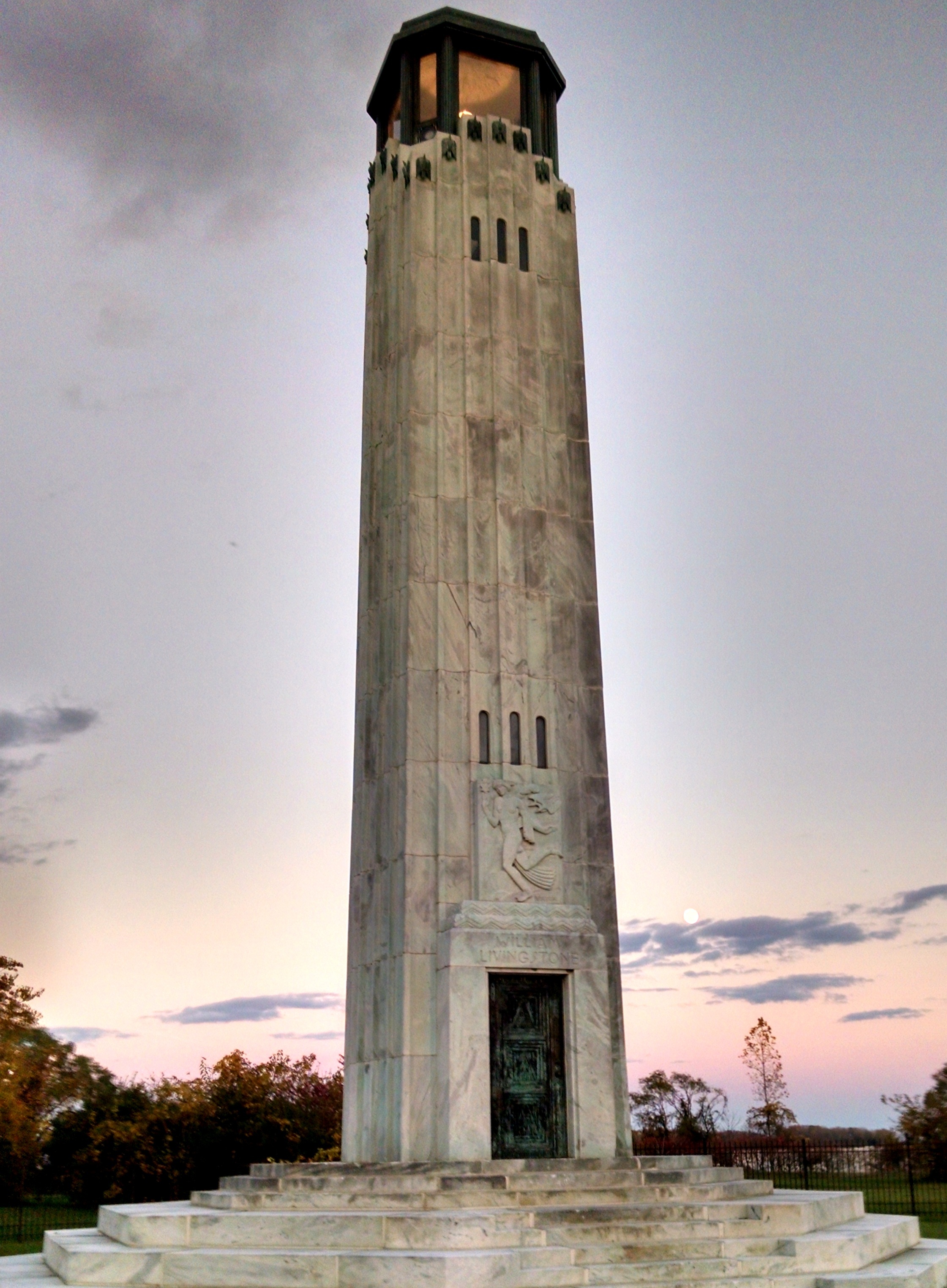William Livingstone Memorial Lighthouse

The Livingstone Memorial Lighthouse on Belle Isle was named after Detroit’s William Livingstone. Born in 1844, The Livingstone Memorial Lighthouse of Belle Isle was named after Detroit’s William Livingstone. Livingstone, born in 1844, was president of the Dime Bank, owner of the Detroit Evening Journal, and president of the Lake Carriers Association for a long time. He also was responsible for several significant navigational improvements to the Great Lakes, including the establishment of a deep-water channel known as the Livingstone Channel in the lower Detroit River. Friends and colleagues across the city rallied to build a suitable monument in Livingstone’s memory after his death in 1925.
The Livingstone Memorial Lighthouse, designed by architect Detroit Albert Kahn, was located on the northern tip of Belle Isle, facing Lake St. Clair. In 1930, Hungarian sculptor Geza Maroti designed the ornamentation of the monument in the Art Deco style, a classic fluted pillar but with increased modern opulence. The 58-foot-tall lighthouse, the only such structure in North America, was sculpted out of Georgian marble.
Originally from the older Belle Isle Lighthouse, which was demolished in 1941 to make room for the Coast Guard station, its bronze and glass lens produces an 8600-candlepower beacon visible for up to fifteen miles. The thieves broke into the lighthouse in 1980, stealing two of the four lamps. In response, a fence around the lighthouse was erected by the City of Detroit to prevent further vandalism, a project that cost about $100,000. detroithistorical.org – Livingstone Memorial Lighthouse
History
William Livingstone was born to Scottish parents in Dundas, Ontario, on January 21, 1844, and moved to Detroit as a child and graduated from city schools in 1862. Livingstone began his multidimensional career soon after graduating, which would see him rise to power in banking, publishing, and transportation to the Great Lakes. In 1865, Livingstone started a shipping business with his dad after having to serve as an apprentice machinist in Detroit’s railroad shops. In 1885, Livingstone acquired the Detroit Evening Journal, and he became president of Dime Savings Bank in April 1900, a position he held until October 17, 1925, when he died in the bank building in his office.
With all his achievements, for his achievements to shipping on the Great Lakes, Livingstone is best remembered. In 1880, he established the Michigan Navigation Company and then served as general manager of the Percheron Steam Navigation Company, responsible for building the Palmer and Livingstone steamships, which were the largest ships on the Great Lakes at 297 feet in length.
Livingstone served as president of the Lake Carriers’ Association from 1902 until his death in 1925. In this role, he was instrumental in persuading the Federal Government to construct the 1,350-foot Davis and Sabin locks at Sault Ste. To deepen and straighten channels in the St. Marys River and across Lake St. Clair, and to construct an independent waterway in the lower Detroit River for downbound vessels. Work began in 1908 on this last project, which was named Livingstone Channel to honor the president of the Lake Carriers’ Association, and opened to trade on October 19, 1912, with the procession being led by the freighter William Livingstone.
Tribute
As a tribute to William Livingstone, on land donated by the City of Detroit and with funds provided by the Lake Carriers’ Association and Detroit citizens, a memorial lighthouse was built at the east end of Belle Isle Park.
The Memorial Lighthouse, designed by Albert Kahn and built for $100,000 in Georgia marble, was not the first lighthouse built on Belle Isle. A lighthouse was built on Belle Isle in 1881 after Congress appropriated $10,000, and put into operation for the first time on the night of May 15, 1882. A square, redbrick tower with an attached two-story brick dwelling consisted of the original Belle Isle Lighthouse and was equipped with a fourth-order Fresnel lens that from the southeast point of the island displayed a fixed red light. In 1891, a circular oil house was added to the station.
For over forty years, Louis Fetes was the keeper of the Belle Isle Lighthouse, staffing the lighthouse almost the entire time. There was no bridge connecting it to the mainland when he arrived on the island in 1886, and to reach Detroit, Keeper Fetes would row to the Canadian bank of the water, walk a few miles, then take the Walkerville ferry. In 1889, Fetes brought his wife to the island, and six children were raised at the lighthouse by the couple. While the family lived at the lighthouse, Belle Isle was reshaped into a playground in Detroit. The automation of the lighthouse in 1930 is said to have broken the heart of Keeper Fetes and he died at the age of seventy the following year.
The Detroit superintendent of the Lighthouse Service, after the light was automated, lived in the lighthouse until 1940, when the dwelling was abandoned. Belle Isle Light was moved from the lighthouse in 1935 to a combined flagpole and light mast nearby. Park trees were beginning to obscure Belle Isle Light, and the Lighthouse Service chose to erect the new flagpole, which was constructed to harmonize with its surroundings, rather than perform extensive trimming or raising the lighthouse tower. The flagpole was seventy feet tall and had a bracket that supported a 300 mm aluminum lantern at a height of forty feet. The lantern was equipped with a commercial power-fed 300-watt electric lamp and could be raised or reduced using a small hand winch attached to the pole. A warning bell was rung in the event of the current failure and a back-up light in the main tower was activated.
In the fall of 1941, the Belle Isle Lighthouse was demolished to make room for a $250,000 Coast Guard station. In 1943, Belle Isle Light was moved to the new brick lookout tower of the Coast Guard station, where its focal plane was thirty-three feet higher than the flagpole. On Belle Isle, not far from the memorial lighthouse, the Coast Guard station is still active and Belle Isle Light is displayed from a pole on the property.
In July 1980, Vandals broke into the William Livingstone Memorial Lighthouse and stole from the lantern room two of their four ninety-pound lenses. To deter further vandalism, two iron bars were placed across the door of the lighthouse, but the lighthouse was broken into again in January 1981, and graffiti was spray-painted on a temporary plastic lens used above the lighthouse.
Today, William Livingstone Memorial Lighthouse alternately sends out a white and red flash separated by ten seconds and continues to remind visitors of the achievements of one of the most prominent and public-spirited citizens of Detroit, William Livingstone. lighthousefriends.com – William Livingstone Memorial Lighthouse
